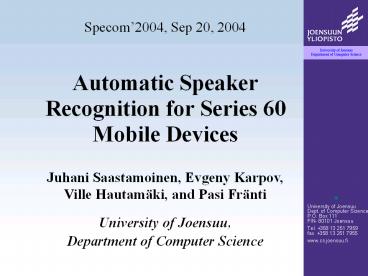Automatic Speaker Recognition for Series 60 Mobile Devices - PowerPoint PPT Presentation
Title:
Automatic Speaker Recognition for Series 60 Mobile Devices
Description:
Truncation and re-scaling to avoid overflows in the converted algorithm ... Multiplication: 32 x 32 -bit result must fit in 32 bits: truncate input ... – PowerPoint PPT presentation
Number of Views:73
Avg rating:3.0/5.0
Title: Automatic Speaker Recognition for Series 60 Mobile Devices
1
Automatic Speaker Recognition for Series 60
Mobile Devices
Specom2004, Sep 20, 2004
Juhani Saastamoinen, Evgeny Karpov, Ville
Hautamäki, and Pasi Fränti
- University of Joensuu,
- Department of Computer Science
2
Background
- Project in National FENIX programme
- New Methods and Applications in Speech Technology
- 7 research institutes
- Project partners NRC, Lingsoft, National Bureau
of Investigation, etc. - Joensuu Speaker Recognition
- http//cs.joensuu.fi/pages/pums
3
PUMS project
Juhani Saastamoinen Project manager
Pasi Fränti Professor
Evgeny Karpov Project researcher
Tomi Kinnunen Researcher
Ismo Kärkkäinen Clustering algorithms
Ville Hautamäki Project researcher
4
Application Scenarios
5
Project Goal
Port speaker recognition to Series 60 mobile phone
6
Symbian Phones
- Series 60 phone features
- 16 MB ROM
- 8 MB RAM
- 176 x 208 display
- ARM-processor
- No floating-point unit!!!
UIQ
Series 60
Series 80
7
Symbian OS
- Defined by Symbian consortium
- Based on EPOC
- Operating system for mobile phones
- Real-time system
- Long uptime required
- Multitasking, multithreading
8
Problems of Porting
- Usual considerations when porting to phone
- GUI event driven program(ming)
- Platform specific programming model
- Real-time system, exceptions
- Application specific porting problems
- Number crunching without floating point unit!!!
- Signal processing numerically challenging
9
Identification System
Add speaker profiles during training
Read and use all profiles during recognition
Speaker Profile Database
Decision
10
MFCC Signal Processing
- pre-emph. coeff. 0.97, Hamm window, 30 triangular
mel-filters, base-2 logarithm, output 12 MFCC's
11
Fixed-Point Implementation
- Numerical analysis needed for fixed-point
arithmetic implementation - Truncation and re-scaling to avoid overflows in
the converted algorithm - Minimize information loss caused by computation
in fixed-point arithmetic - Minimize relative error
12
FFT, Fixed-Point
- Frequency spectrum of speech
- Biggest source of numerical error
- Butterflies have multiplications
- Layers repeat truncation errors
- Fixed number of bits per element
- 32, native integer size in many systems
- Reference implementation FFTGEN
- http//www.jjj.de/fft/fftgen.tgz
13
FFTGEN (16/16)
- Multiplication 32 x 32 -bit result must fit in
32 bits truncate input - FFTGEN Truncate inputs to 16/16 bits
FFT layer input
FFT Twiddle Factor
X
16-bit integer
16-bit integer
X
32-bit multiplication result
16 used bits
16 crop-off bits
FFT layer output (part of it) Crop-off for next
layer 16 bits!
16-bit integer
14
Info Preserving FFT (22/10)
- Approximate DFT operator F with G
- Increase F-G, preserve more signal
information - minimize maximum relative error in scaled sine
values with respect to scale 980 good for FFT
sizes up to 1024 - Truncate multiplication inputs to 22/10 bits
(signal/op)
FFT layer input
FFT Twiddle Factor
X
32-bit integer
22 used bits
10 crop-off bits
32-bit integer, 22 bits used
16-bit integer, 10 bits used
X
FFT layer output (part of it) Crop-off for next
layer 10 bits
32-bit multiplication result
15
FFT Spectrum, Fixed-Point
- x-axis fixed-point FFT element abs. values
- y-axis correct FFT element abs. values
16/16 abs values
22/10 abs values
original TIMIT signal
TIMIT signal x 4
16
Scale of Error in Proposed FFT
17
Magnitude Spectrum, Fixed-Point
- Compute complex absolute values using maximum
coordinate and coordinate ratio - Suppose x gt y for z x i y, then
- Interpret the (squared) y/x by t
- Approx. square root by a polynomial P(t)
- Constant time algorithm (vs. Newton)
18
Logarithm, Fixed-Point
- Use base 2 instead of base 10
- corresponds to output multiplication
- Standard technique
- Return problem to interval 1,2)
- Use linear interpolation from values stored in a
look-up table - 8 bits used for indexing the look-up table values
19
Rest of System, Fixed-Point
- No improvement needed in VQ/GLA
- Should apply similar technique as with FFT to
other signal processing - Pre-emphasis, utilize full 32 bits
- Time windowing, use less bits in windowing
function - FB, use less bits in frequency responses
- DCT, use less bits for the cosines
20
Effect of Signal Processing
- TIMIT data sets, varying number of speakers (N)
- For each N repeat (6x, 5x, 2x) train/recognize
cycles (eliminate GLA initial solution
randomness) - FFTGEN FFT with 16/16 multiplication
- Fixed-point use proposed 22/10 FFT
- Mixed floating-point DSP, fixed-point GLA/VQ
21
Effect of Signal Quality
- GSM/PC data 16 aligned dual recordings
- All computations in floating-point arith.
- Signal recorded with laptop and PC mic gives
average recognition rate 100 - Signal recorded with Nokia 3660 results in
average recognition rate 84,9
22
Conclusion
- Speaker identification was ported to Symbian
Series 60 mobile phone - 22/10 bit usage in multiplication proposed
instead of standard 16/16 - Experiments indicate that recognition accuracy
improves from 68 to 95

